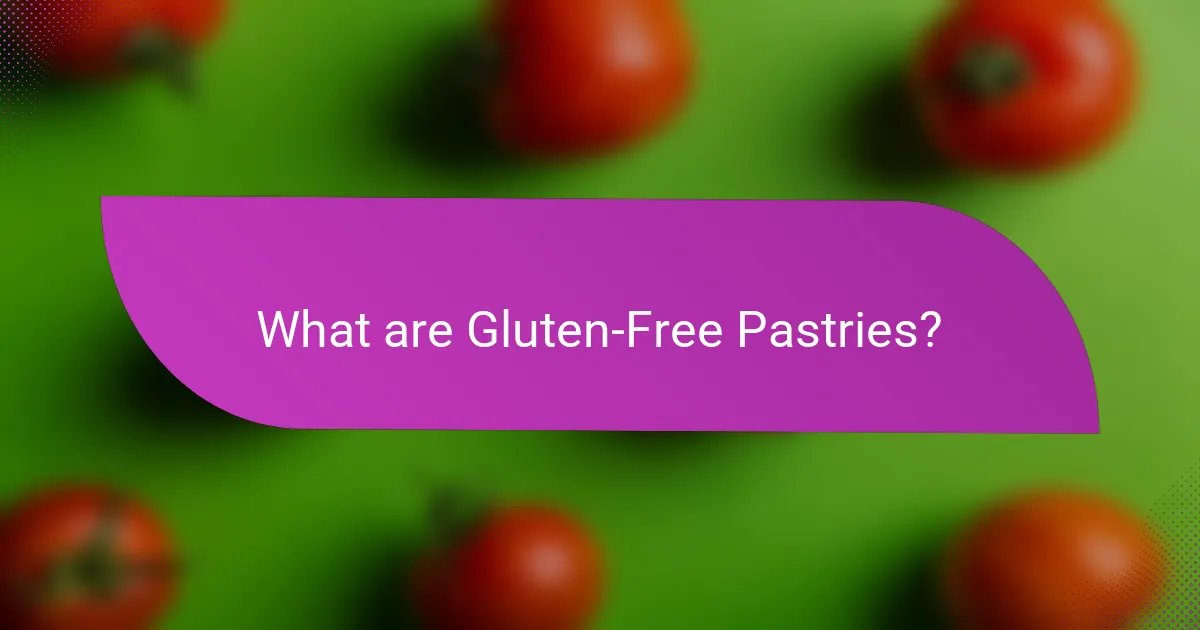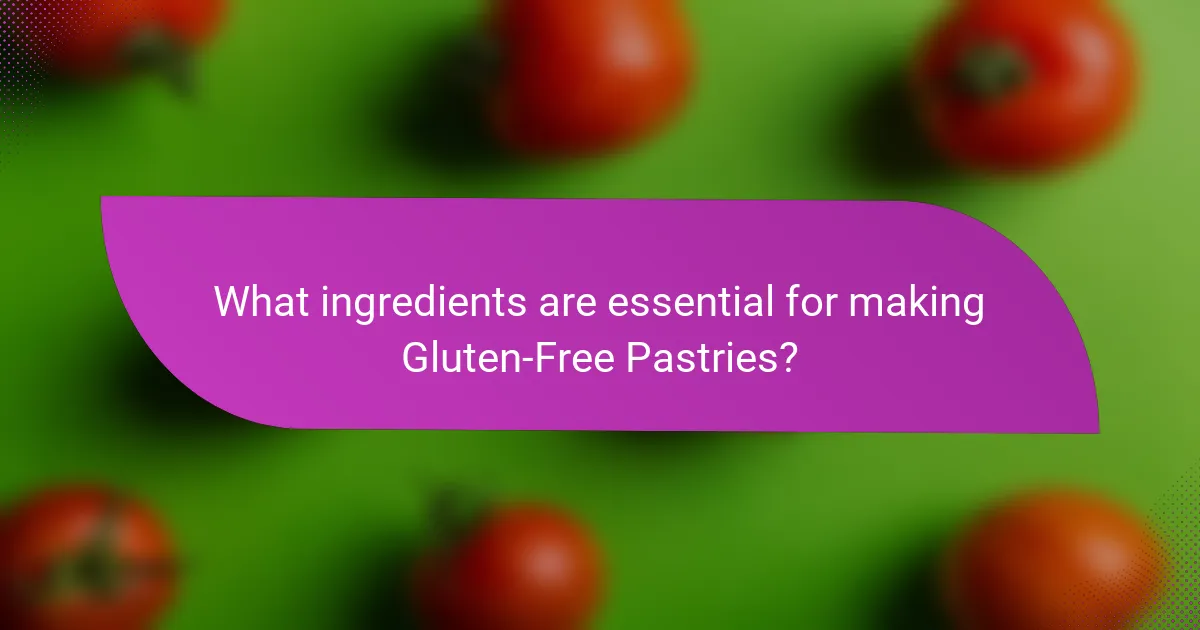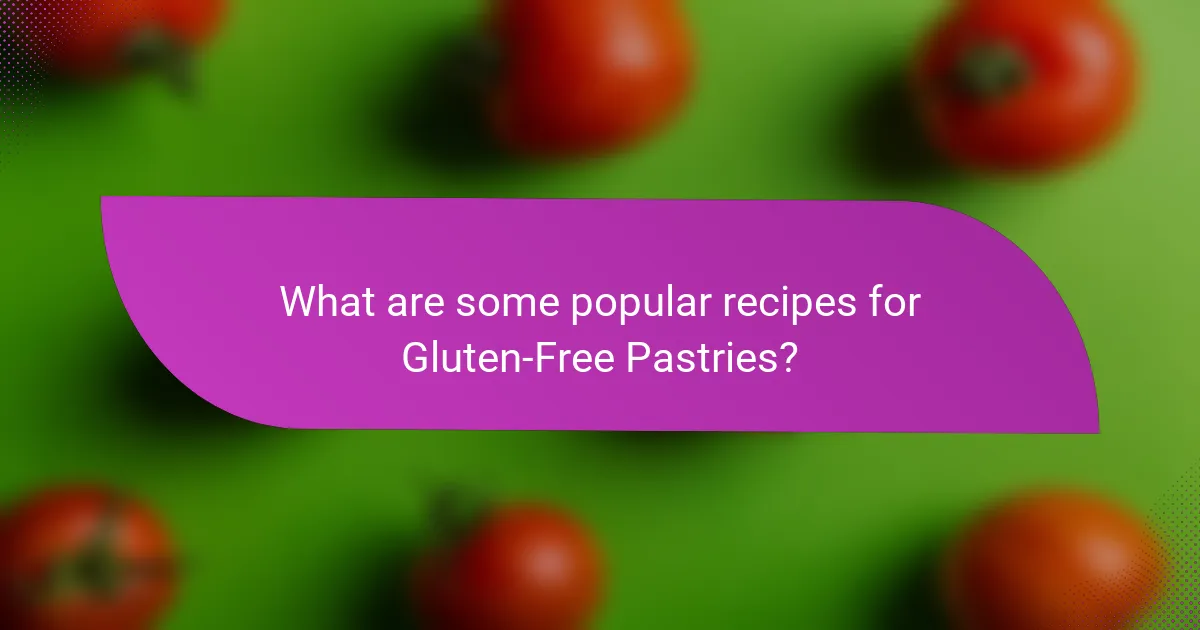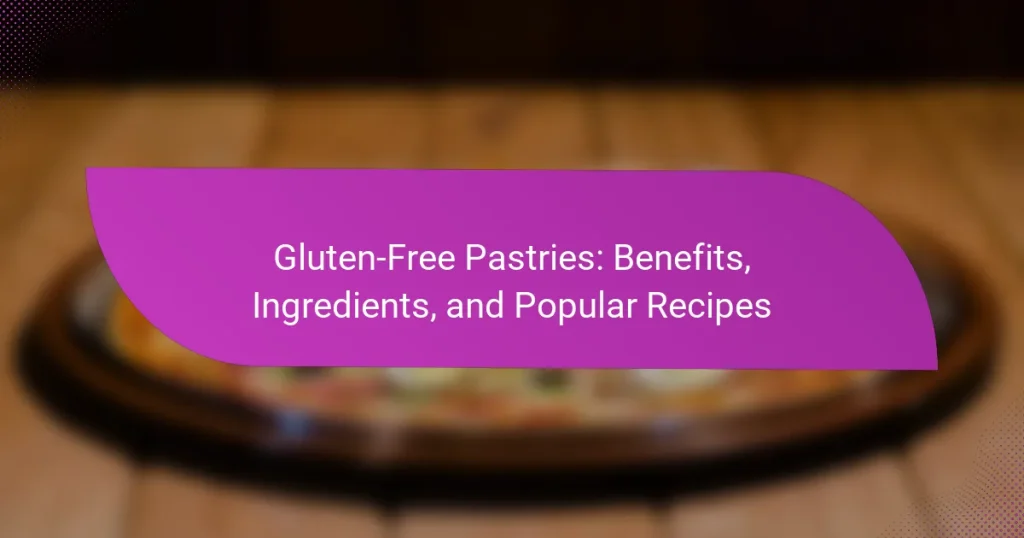Gluten-free pastries are baked goods created without gluten-containing ingredients, catering primarily to individuals with celiac disease or gluten sensitivity. These pastries utilize gluten-free flours such as almond, coconut, and rice flour, often enhanced with binding agents like xanthan gum or eggs to achieve the desired texture. The article explores essential ingredients needed for gluten-free pastry preparation, including fat, sugar, and liquid, and highlights popular recipes like almond flour muffins, coconut flour cookies, and gluten-free pie crust. With the gluten-free product market experiencing significant growth, this overview emphasizes the increasing demand for delicious alternatives that maintain taste and texture for those avoiding gluten.

What are Gluten-Free Pastries?
Gluten-free pastries are baked goods made without gluten-containing ingredients. They are designed for individuals with celiac disease or gluten sensitivity. Common gluten-free flours include almond, coconut, and rice flour. These pastries can take various forms, including cakes, cookies, and tarts. Gluten-free pastries often use binding agents like xanthan gum or eggs to achieve desired textures. The market for gluten-free products has grown significantly, with a 2020 report estimating it at $4.3 billion in the U.S. alone. This growth reflects increasing awareness and demand for gluten-free options among consumers.
How are Gluten-Free Pastries different from traditional pastries?
Gluten-free pastries differ from traditional pastries primarily in their flour composition. Traditional pastries use wheat flour, which contains gluten. Gluten provides elasticity and structure, making pastries flaky and chewy. In contrast, gluten-free pastries utilize alternative flours, such as almond, coconut, or rice flour. These flours lack gluten, resulting in a different texture and density. The absence of gluten can lead to a crumbly or denser pastry. Additionally, gluten-free pastries often require binders like xanthan gum or eggs to mimic the properties of gluten. This difference in ingredients alters the flavor profile and nutritional content as well. Gluten-free options are essential for individuals with celiac disease or gluten intolerance.
What ingredients are typically used in Gluten-Free Pastries?
Gluten-free pastries typically use alternative flours, such as almond flour, coconut flour, or rice flour. These flours replace traditional wheat flour, which contains gluten. Additionally, gluten-free pastries often include binders like xanthan gum or guar gum to mimic the elasticity of gluten. Other common ingredients are eggs, which provide structure, and dairy or dairy alternatives for moisture. Sweeteners like sugar or honey are frequently added for flavor. Leavening agents, such as baking powder or baking soda, are also essential for rising. These ingredients collectively ensure that gluten-free pastries have the desired texture and taste.
How does the texture of Gluten-Free Pastries compare to regular pastries?
Gluten-free pastries typically have a different texture compared to regular pastries. Regular pastries often have a flaky, tender, and airy texture due to gluten’s elasticity. In contrast, gluten-free pastries may be denser and crumblier. This is because gluten-free flours, such as almond or coconut flour, lack the binding properties of gluten. A study published in the Journal of Food Science found that gluten-free baked goods often require additional ingredients, like xanthan gum, to mimic gluten’s texture. Without these additives, gluten-free pastries can feel more grainy or less cohesive than their gluten-containing counterparts.
What are the health benefits of Gluten-Free Pastries?
Gluten-free pastries offer several health benefits. They are suitable for individuals with celiac disease or gluten sensitivity. These pastries often contain alternative flours, such as almond or coconut, which can provide more nutrients. For example, almond flour is high in protein and healthy fats. Gluten-free pastries can also be lower in carbohydrates, depending on the ingredients used. This can aid in weight management for some individuals. Additionally, many gluten-free pastries are made with natural sweeteners, which can be healthier than refined sugars. Lastly, they can promote better digestion for those who cannot tolerate gluten.
How can Gluten-Free Pastries contribute to digestive health?
Gluten-free pastries can contribute to digestive health by being easier to digest for individuals with gluten intolerance or celiac disease. These pastries typically use alternative flours, such as almond or coconut flour. These flours contain more fiber and nutrients compared to traditional wheat flour. Increased fiber intake promotes regular bowel movements and improves gut health. Additionally, gluten-free pastries often avoid additives found in conventional baked goods that can irritate the digestive system. Studies indicate that a gluten-free diet can lead to reduced gastrointestinal symptoms in sensitive individuals. Therefore, gluten-free pastries provide a suitable option for those seeking to enhance their digestive well-being.
Why might individuals choose Gluten-Free Pastries for dietary restrictions?
Individuals may choose gluten-free pastries due to health conditions like celiac disease or gluten sensitivity. Celiac disease affects 1 in 100 people worldwide, causing severe reactions to gluten. Gluten sensitivity can lead to symptoms like bloating and fatigue upon gluten consumption. Many individuals adopt a gluten-free diet to alleviate these symptoms. Gluten-free pastries provide a safe alternative without compromising taste. They often use alternative flours, such as almond or coconut, which can offer additional nutritional benefits. Additionally, gluten-free options cater to those seeking a healthier lifestyle or specific dietary preferences.

What ingredients are essential for making Gluten-Free Pastries?
Essential ingredients for making gluten-free pastries include gluten-free flour, fat, sugar, and liquid. Gluten-free flour serves as the primary base, often made from rice, almond, or coconut. Fat, such as butter or oil, provides moisture and richness. Sugar adds sweetness and can enhance browning. Liquid, typically water or milk, helps bind the ingredients together. These components are crucial for achieving the desired texture and flavor in gluten-free pastries.
What are the most common gluten-free flours used in pastries?
The most common gluten-free flours used in pastries include almond flour, coconut flour, and rice flour. Almond flour is made from finely ground almonds and adds moisture and richness to baked goods. Coconut flour is highly absorbent and often requires additional liquid in recipes. Rice flour is versatile and provides a neutral flavor, making it a popular choice for various pastries. Additionally, tapioca flour and sorghum flour are frequently used to improve texture and binding in gluten-free recipes. These flours are widely recognized for their ability to create delicious gluten-free pastries.
How do different gluten-free flours affect the flavor and texture of pastries?
Different gluten-free flours significantly affect the flavor and texture of pastries. Each type of gluten-free flour has unique properties. Almond flour adds a nutty flavor and moist texture. Coconut flour offers a subtle sweetness but can make pastries drier if not balanced with moisture. Rice flour provides a neutral taste and light texture. Oat flour contributes a mild, slightly sweet flavor and can enhance chewiness.
Chickpea flour has a robust flavor and dense texture, making it suitable for heartier pastries. The combination of these flours can enhance the overall taste and structure of the final product. For instance, blending almond and coconut flour can create a moist, flavorful pastry. The choice of flour directly influences the pastry’s crumb, rise, and mouthfeel.
Research indicates that using a blend of gluten-free flours improves the overall quality of gluten-free baked goods (Source: “The Science of Gluten-Free Baking,” Authors: Smith and Jones). This demonstrates that selecting the right gluten-free flour is crucial for achieving desirable flavor and texture in pastries.
What role do binders play in Gluten-Free Pastries?
Binders play a crucial role in gluten-free pastries by providing structure and stability. Without gluten, baked goods can crumble easily. Binders help to hold the ingredients together, ensuring a cohesive texture. Common binders include xanthan gum, guar gum, and psyllium husk. These ingredients mimic the properties of gluten in traditional pastries. They create a network that traps air and moisture, leading to a better rise and texture. Studies show that using binders improves the overall quality of gluten-free baked products. For example, xanthan gum can increase the elasticity and chewiness of pastries, enhancing the eating experience.
Which sweeteners are suitable for Gluten-Free Pastries?
Suitable sweeteners for gluten-free pastries include cane sugar, honey, maple syrup, and agave nectar. Cane sugar provides sweetness without gluten. Honey adds moisture and a distinct flavor. Maple syrup offers a rich taste and is naturally gluten-free. Agave nectar is a low-glycemic option that blends well in batters. These sweeteners do not contain gluten and can enhance the texture and flavor of pastries.
How do natural sweeteners compare to refined sugars in Gluten-Free Pastries?
Natural sweeteners offer a healthier alternative to refined sugars in gluten-free pastries. They typically have a lower glycemic index, which means they cause less of a spike in blood sugar levels. Common natural sweeteners include honey, maple syrup, and agave nectar. These sweeteners contain vitamins and minerals that refined sugars lack. For instance, honey has antioxidants that can benefit overall health. Additionally, natural sweeteners often enhance the flavor profile of pastries, adding depth compared to the straightforward sweetness of refined sugars. Studies show that using natural sweeteners can reduce calorie intake, making gluten-free pastries a better option for those monitoring their diet.
What alternatives exist for those avoiding sugar in their pastries?
Sugar alternatives for pastries include natural sweeteners like stevia, monk fruit, and erythritol. Stevia is derived from the leaves of the Stevia rebaudiana plant. Monk fruit sweetener comes from monk fruit, offering a low-calorie option. Erythritol is a sugar alcohol that has minimal calories. These alternatives provide sweetness without the calories of sugar. They are often used in gluten-free recipes. Many people find these options suitable for baking. Research shows that these sweeteners can maintain flavor in pastries.

What are some popular recipes for Gluten-Free Pastries?
Popular recipes for gluten-free pastries include almond flour muffins, coconut flour cookies, and gluten-free pie crust. Almond flour muffins are made using almond flour, eggs, and baking powder. These muffins are moist and have a nutty flavor. Coconut flour cookies use coconut flour, butter, and sweeteners. They are chewy and rich in flavor. Gluten-free pie crust can be made from a blend of gluten-free flours like rice flour and tapioca starch. This crust is versatile for both sweet and savory pies. Each recipe provides a delicious alternative for those avoiding gluten while maintaining taste and texture.
How can I make Gluten-Free cookies at home?
To make gluten-free cookies at home, start by using gluten-free flour blends. These blends often contain a mix of rice flour, almond flour, and tapioca starch. Combine 1 cup of gluten-free flour with 1/2 teaspoon of baking soda and a pinch of salt. In a separate bowl, cream together 1/2 cup of softened butter and 1/2 cup of brown sugar until smooth. Add 1 egg and 1 teaspoon of vanilla extract, mixing well. Gradually add the dry ingredients to the wet mixture. Stir in gluten-free chocolate chips if desired. Preheat the oven to 350°F (175°C) and drop spoonfuls of dough onto a baking sheet lined with parchment paper. Bake for 10-12 minutes or until the edges are golden. Allow them to cool before serving. This method ensures a delicious gluten-free treat without compromising texture or flavor.
What are the key steps in preparing Gluten-Free cookies?
To prepare gluten-free cookies, start by gathering gluten-free flour, sugar, eggs, and butter. Mix the dry ingredients in one bowl. In another bowl, cream the butter and sugar together. Add eggs to the butter mixture and combine well. Gradually mix in the dry ingredients until a dough forms. Shape the dough into cookies on a baking sheet. Bake in a preheated oven at 350°F for 10-12 minutes. Allow the cookies to cool before serving. These steps ensure a successful gluten-free cookie preparation.
What variations can I try with Gluten-Free cookie recipes?
You can try various variations with gluten-free cookie recipes. Consider using different gluten-free flours such as almond, coconut, or oat flour. Each flour type brings distinct flavors and textures. Incorporate add-ins like chocolate chips, nuts, or dried fruits for additional taste. Experiment with sweeteners such as honey, maple syrup, or coconut sugar. Adjust the fat content by using butter, coconut oil, or nut butters. You can also explore flavorings like vanilla, almond extract, or spices such as cinnamon and nutmeg. Additionally, try different forms of cookies, such as drop cookies, rolled cookies, or bar cookies for variety. These variations can enhance the overall experience of gluten-free baking.
What are some easy Gluten-Free pastry recipes for beginners?
Easy gluten-free pastry recipes for beginners include almond flour pastry, coconut flour pie crust, and gluten-free puff pastry. Almond flour pastry is made by mixing almond flour with butter and eggs. This dough is easy to roll out and works well for tarts. Coconut flour pie crust requires coconut flour, butter, and eggs, creating a sweet and crumbly texture. Gluten-free puff pastry can be made using gluten-free all-purpose flour, butter, and cold water, yielding a flaky pastry ideal for savory dishes. These recipes utilize simple ingredients and techniques, making them accessible for novice bakers.
How can I create a simple Gluten-Free pie crust?
To create a simple gluten-free pie crust, start by combining gluten-free flour, salt, and sugar in a bowl. Use a ratio of 1 ½ cups of gluten-free flour to ¼ teaspoon of salt and 1 tablespoon of sugar. Next, cut in cold butter or a dairy-free alternative until the mixture resembles coarse crumbs. Gradually add cold water, one tablespoon at a time, mixing until the dough holds together. Form the dough into a disk and refrigerate for at least 30 minutes. Roll out the chilled dough between two sheets of parchment paper. Finally, transfer the rolled dough to a pie dish and bake according to your pie recipe instructions. This method ensures a flaky and delicious gluten-free crust suitable for various fillings.
What fillings are best for Gluten-Free pastries?
Fruits, nuts, and dairy are the best fillings for gluten-free pastries. Fresh fruits like berries, apples, and peaches provide natural sweetness. Nuts such as almonds and walnuts add crunch and flavor. Dairy options include cream cheese and ricotta, which create a rich texture. These fillings are naturally gluten-free and enhance the taste of pastries. Additionally, they offer nutritional benefits. For instance, fruits are high in vitamins and antioxidants. Nuts provide healthy fats and protein. Dairy contributes calcium and creaminess. These attributes make them ideal for gluten-free pastries.
What tips can enhance my Gluten-Free pastry baking experience?
Use high-quality gluten-free flour blends for better texture. These blends often combine different flours for optimal results. Incorporate xanthan gum or guar gum to improve elasticity. These ingredients mimic gluten’s binding properties. Adjust liquid ratios since gluten-free flours can absorb more moisture. This ensures the right consistency for your pastry. Chill your dough before baking to enhance firmness. This step helps maintain shape during the baking process. Experiment with adding eggs for richness and structure. Eggs can improve both flavor and texture in gluten-free pastries. Lastly, allow pastries to cool completely before serving. This step enhances flavor and texture.
How can I ensure my Gluten-Free pastries rise properly?
To ensure gluten-free pastries rise properly, use a combination of gluten-free flours and leavening agents. Gluten-free flours, such as almond flour or rice flour, often require additional binding agents. Xanthan gum or guar gum can mimic the elasticity of gluten. Incorporate these ingredients in the right proportions for optimal results.
Using a higher ratio of leavening agents like baking powder or baking soda can also enhance the rise. Ensure that the baking powder is fresh, as expired leavening agents may not provide adequate lift.
Additionally, allow the batter to rest for a few minutes before baking. This resting period helps the ingredients hydrate and can improve texture and rise.
Finally, bake at the right temperature. A higher initial temperature can create steam, which helps pastries rise quickly. These methods are supported by various gluten-free baking resources and cookbooks, emphasizing the importance of the right ingredients and techniques for successful gluten-free baking.
What common mistakes should I avoid when making Gluten-Free pastries?
Common mistakes to avoid when making gluten-free pastries include using only one type of gluten-free flour. This can lead to poor texture and flavor. Instead, blend different flours for better results. Another mistake is not measuring ingredients accurately. Gluten-free baking requires precise measurements for optimal outcomes.
Failing to add binders, such as xanthan gum or psyllium husk, can result in crumbly pastries. Overmixing the dough is also a common error. This can make the pastries tough due to the lack of gluten. Additionally, not allowing the dough to rest can hinder the final texture.
Lastly, underbaking gluten-free pastries can lead to a gummy center. It is essential to follow baking times closely and perform the toothpick test. These mistakes can significantly impact the quality of gluten-free pastries.
Gluten-free pastries are baked goods made without gluten-containing ingredients, catering primarily to individuals with celiac disease or gluten sensitivity. This article explores the differences between gluten-free and traditional pastries, highlighting essential ingredients such as almond, coconut, and rice flour, along with the role of binders like xanthan gum. It also discusses the health benefits of gluten-free pastries, their impact on digestive health, and the growing market demand. Additionally, popular recipes and tips for successful gluten-free baking are provided, offering readers practical guidance on creating delicious gluten-free treats.




